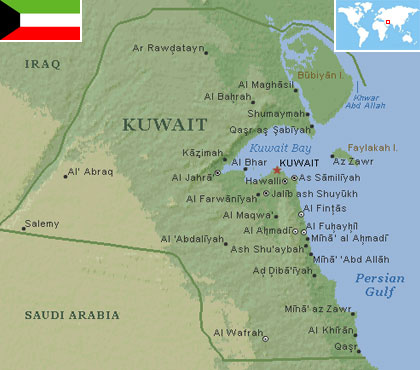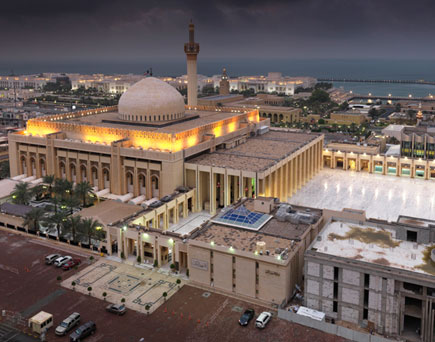Kuwait
Country statistics

Total area: 6,880 sq miles (17,819 sq km)
Population (2012 est.): 2,646,314 (growth rate: 1.883%); birth rate: 20.96/1000; infant mortality rate: 7.87/1000; life expectancy: 77.28
Capital City: Kuwait
Monetary unit: Kuwaiti dinar (KD)
Languages: Arabic (official), English
Ethnicity/race: Kuwaiti 45%, other Arab 35%, South Asian 9%, Iranian 4%, other 7%
Religions: Islam 85% (Sunni 70%, Shiite 30%); Christian, Hindu, Parsi, and other 15%
Country introduction

Kuwait lies in the north-western part of the Arabian Gulf, which borders Iraq to north-west, Saudi Arabia to south and south-west, and the shores of the Arabian Gulf to the west.
Physically, the terrain of Kuwait is generally low and flat, and primarily covered in sand, with the highest elevation only rising up to 306 m (1,003 ft). The only true variation to this flat desert is in the country's north-east near the Tigris and Euphrates River delta, where there are some swamps, but few of any true significance.
Most of the Arabian Desert covers the State of Kuwait. Underneath the sandy desert are limestone formations, the source of the oil deposits. Kuwait has some of the richest oil fields in the world. While part of the land is arable, the country lack ample supply of water for irrigation. Most of the oil deposits are located in the north and west of the country underneath the layers of gravel, sand, clay and silt on top of the limestone.
Kuwait has nine islands, all of which with the exception of Failaka Island are uninhabited. The largest of islands are Bubiyan and Al-Warbah. Bubiyan is the largest island in Kuwait and is connected to the rest of the country by a 2,380 m (7,808 ft) long bridge. The land area is considered arable and sparse vegetation is found along its 500 km long coastline. The most popular island is Failakah mainly because people actually live on it, but more importantly, the island was once occupied by Alexander and was named Ikarus by the Greeks.
The culture

Kuwait is predominantly an Islamic country with mosques in every town and city. Mosques are the Muslims' place of worship where people visit every day to do their five daily prayers as a united group. Every day when the sun rises, around noon, in the afternoon, at sun set and at night, the prayers are called in every mosque in Kuwait.
The influence of Islamic and Arab culture on its architecture, music, attire, cuisine and lifestyle is prominent. The most distinctive characteristic of local Kuwaiti culture are the dewaniya's, a large reception room used for social gatherings attended mostly by close family members. Alcohol is forbidden and consequently there are no pubs or nightclubs or big music concerts. However, there are plenty of family entertainment options, restaurants, cinemas, cafes and private parties.
Unlike neighboring Saudi Arabia, the Islamic dress code is not compulsory. Many of the older Kuwaiti men prefer wearing dish dasha, an ankle-length white shirt woven from wool or cotton while the minority of women wear abaya, black over-garment covering most parts of the body. This attire is particularly well-suited for Kuwait's hot and dry climate. Western-style clothing is also fairly popular, especially among Kuwait's youth.
Ramadan is the most important festival of the Muslims and it happens once a year, where a month long fasting is observed by the entire nation. Eid-ul-Fitr is celebrated outstandingly as it marks the end of Ramadan. The joyous Hala Festival which happens every February marks the arrival of spring and is one of the major festivals in Kuwait. This month long festival is of special significance for Kuwaitis as the National Day and Liberation Day of the nation of Kuwait fall in this special month. The celebrations include public gatherings, pyrotechnics, assemblies and lots of enjoyment by the people. Traditional Kuwaiti dancers take to the streets showing off their customary attire and age-old dancing skills. Many special sporting events are also conducted in the country, with international and local level contests held in a variety of sports.
Seafood has been the mainstay of the Kuwaiti diet for centuries and include shrimp, hamour (grouper), hamra (red snapper), and the local favorite, zubaidi (pomfret). Chicken is also frequently on the menu. From the bedouin tradition comes grilled, skewered meat, both cubed and ground. Traditionally, the meat would be lamb (mutton), but the ease of international trade has made beef more accessible. Pork is not available in Kuwait, as it is forbidden in Islamic tradition. The Arabs in the Persian Gulf region played a crucial role in the spice trade between India and Europe and spices have remained an important ingredient of Kuwaiti cuisine. Traditional Kuwaiti cuisine includes Machboos or Kabsa which borrows heavily from South Asian cuisine.
Before the discovery of oil, pearling formed a crucial part of Kuwait's economy. Pearl fishery, known as ghaus, suffered decline after the advent of Japanese pearl farming. However, Kuwait's pearl industry laid the foundation of its rich maritime history. Dhows, large wooden ships made from teak wood imported from India, became an indistinct part of Kuwait's maritime fleet and dhow building is still practiced in this Persian Gulf state.
Attractions & landmarks

Kuwait City, the country's dynamic capital, is bustling with attractions and activities. Architectural highlights include the impressive Kuwait Towers, consisting of three sky-scrapers, with the highest of the three towers housing a rotating viewing sphere, a restaurant and a coffee shop. The Liberation Tower in particular is considered to be the symbol of Kuwait and the growing economical development of the country. It is also known as the Kuwait Telecommunication Tower and is reported to be the second tallest structure in the country. The tallest building in Kuwait on completion in 2011 is the The Al Hamra Tower at 412.6 m (1,354 ft) high.
One of Kuwait's most impressive landmarks is the Grand Mosque, located opposite the Emir's Palace. Construction of the mosque took nearly seven years at a cost of 46 million dolars, and was opened in 1986. The mosque is the biggest in Kuwait and can accommodate up to 10,000 men in the main prayer hall, and up to 950 women in a separate hall. Opposite the Grand Mosque is the beautiful mosaics of the nearby Seif Palace that have fascinating examples of Islamic art. The palace is best-known for its watch tower features, which are covered in blue tiles, with a roof plated in pure gold.
For those looking to learn more about Kuwait's history and culture, tourists can visit the National Museum and Sadu House, which is dedicated to preserving traditional Bedouin art and culture. For visitors travelling with children, the Scientific Centre is Kuwait's premier family attraction, offering fascinating nature films on a 3D cinema screen and much more.
Kuwait's location on the Persian Gulf also means that it has first-rate beaches and a range of water sports for holidaymakers to enjoy. Scuba diving trips can be arranged or boats can be hired to explore Kuwait from off-shore.
Failaka is amongst the highly visited tourist destinations of the country and is considered one of the most gorgeous and famous historical islands in Kuwait. This popular archeological site unites both the ancient and modern history of Kuwait. Situated in the northern part of the Persian Gulf, the island lies 20 km (12 miles) away from the Kuwait city. The meaning of 'Failaka' in Greek is "outpost" and it was also known as 'Ikaros' by the then Greek immigrants. Visitors can also take boat trips to visit several other remarkable islands like Umm Al-Maradim, Bubiyan, Qaruh, Auhha, Umm Al-Naml, Kubbar, Warba and Miskan.